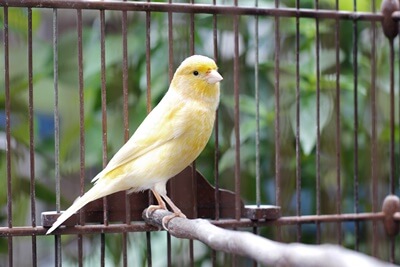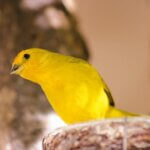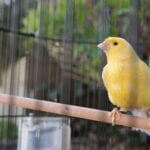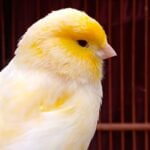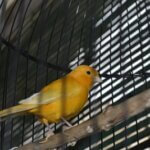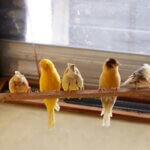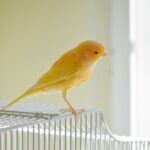Canaries have strange sleeping habits that can be difficult to understand at times. Canaries often sleep in odd places, such as in their food bowls and at the bottom of their cages.
Not all sleeping positions are bad or require you to change something about the way you care for your canary. However, some positions signify a problem that needs to be addressed.
Where Do Canaries Like to Sleep?
Canaries like to sleep where they feel safe and comfortable. However, canaries prioritize safety over comfort when it comes to sleep because they’re small, vulnerable birds.
It would be uncomfortable for a canary to sleep in a cold and wet place. In terms of a perch, a canary would have trouble sleeping if it’s thin and uneven.
How Do Canaries Sleep?
Usually, canaries sleep standing up. Sometimes, they fluff their feathers, turn their faces, and tuck their head under their wings.
While some bird species lay down to sleep, canaries don’t. It isn’t normal for a canary to sleep on its side. If you see your canary sleeping that way, it may be sick or injured.
Explaining Different Canary Sleeping Positions and Locations
How your canary sleeps tells you how it feels. Canaries will change their routine if they feel ill or have an injury, including their sleeping routine.
Sometimes, they’ll change how they position themselves when sleeping or sleep in an unusual spot.
Here are the different canary sleeping positions and meanings:
1/ Sleep On A Perch
Sleeping on a perch is what’s most natural to canaries. They don’t need to lay down to rest and have no problems falling asleep while standing up.
The reason canaries can stay perched all night while asleep is due to the tendons in their legs. When canaries fall asleep, they crouch slightly. As gravity pushes down on the legs, the position causes certain tendons to contract and grip the perch.
As long as they stay crouched that way, they’ll have a firm grip on the perch and won’t fall off, no matter how deeply they sleep.
2/ Sleep in A Nest
Female canaries sleep in nests when they’re watching over their hatchlings.
The female won’t leave the nest until sometime after the eggs have hatched. Canaries co-parent, so the father remains and hunts for food. He takes food to the mother, and she feeds the hatchlings.
A female canary usually begins sleeping in the nest when ready to lay eggs. Female canaries become territorial when nesting, so they stay close to the nest all day and night.
Male canaries don’t need to sleep in nests, but they’ll appreciate an enclosed space where they can hide away and be safe. If you have a sick or elderly canary, let them sleep in a nest.
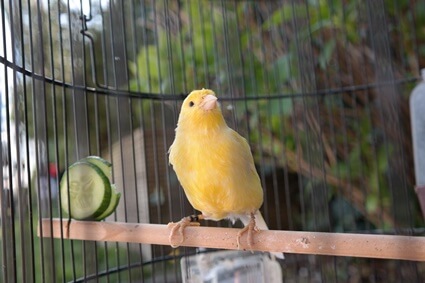
3/ Sleep with Their Head Down
If your canary sleeps with its head tucked, it feels safe with you. According to the University of Vienna, songbirds tuck their head to go into a deep sleep.
Birds sleep with their heads tucked because it helps them conserve energy. Also, it helps prevent heat loss. The body part that dissipates the most heat is the head.
So, by keeping it tucked under the feathers, the canary reduces heat loss. However, sleeping this way also reduces the canary’s awareness.
When songbirds sleep with their heads tucked in, their reaction to predators is far slower.
Birds do their best to remain vigilant, even when they’re asleep. By sleeping with its head tucked, your canary is letting you know that it feels safe enough to lower its guard.
4/ Sleep on Food
If your canary is sleeping in its food bowl, it may be about to molt or is sick.
Your canary likely wants to feel more comfortable by remaining close to its food. If you see your canary sleeping this way, take it to a vet to ensure there are no health concerns.
If it turns out that your canary is just molting, it’s not a concern. It’s a natural and healthy process that’ll pass in its own time.
Even so, you shouldn’t let your canary sleep on its food. While it’s molting, it won’t have the energy to preen itself, so it’ll be covered in food the entire time.
Instead, get your canary a nest to sleep in, which should help it feel more comfortable as it molts.
5/ Sleep with An Eye Open
Canaries sleep with one eye open because birds keep one side of their brain awake while sleeping.
Given how easily they can fall victim to nocturnal predators, sleeping with one eye open helps them react to danger. This kind of sleeping behavior is known as unihemispheric slow-wave sleep.
The eye connected to the ‘awake’ half of the brain is the one that remains open.
The Science of Nature theorizes that keeping an eye open while sleeping also helps flight birds sleep while they fly. Birds developed this form of sleep to reserve energy while flying for long periods.
6/ Sleep with a Raised Leg
Canaries usually sleep with one leg raised to conserve body heat because the parts of their body that aren’t covered in feathers are more prone to heat loss.
However, it could also mean something is wrong with the canary’s leg.
Although it’s normal for canaries to sleep this way, they don’t do it as much as other birds. According to the Journal of Avian Biology, birds with shorter legs adopt this pose less than birds with long legs.
The short-legged birds lose less heat from their legs, so there’s less need to lift them while sleeping.
If your canary does this often, it could be because its leg is sore from standing on hard perches all day. Either that, or it has an injured leg.
You can tell which leg is injured by observing which one it raises. It’s normal for canaries to switch the leg they raise throughout the night, so if your canary only ever raises one leg, you know there’s a problem.
7/ Sleep At The Bottom of The Cage
A canary sleeping at the bottom of the cage is never a good sign. Canaries like being perched up high, where they would be safe from predators in the wild.
So, if your canary is sleeping on the cage floor, it’s likely for one of these reasons:
- Sick and weak
- Scared
- Bullied by other birds
- Dying
- Unable to fly
- About to lay an egg
If your canary is sleeping at the bottom of the cage, you must take it to a vet for a checkup.
How Can I Help My Canary Sleep Comfortably?
To help your canary sleep comfortably, use a cage cover and provide a choice of perches.
Canaries like sleeping in partial darkness, so a cover that wraps around half the cage will help them sleep better. However, not all canaries like this, so experiment with different covers and lighting options.
The best perches for sleeping are soft, padded, or made from rope. These are recommended for long-term perching because they’re soft on the canary’s feet.
However, if your canary already spends a lot of time on soft perches all day, it may not be the best option to give it more soft perches for sleeping.
It’s much healthier for canaries to distribute their weight on different parts of their feet. Hard, curved perches made of wood or concrete are ideal.

